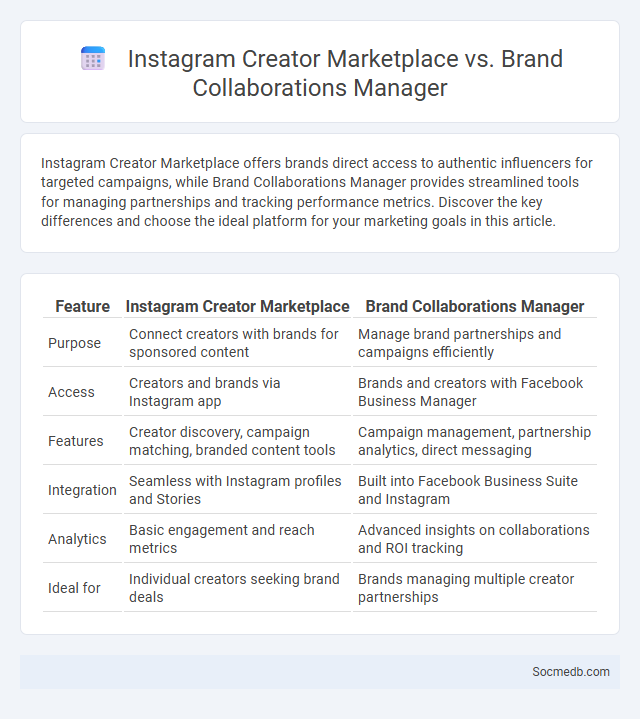
Photo illustration: Instagram Creator Marketplace vs Brand Collaborations Manager
Instagram Creator Marketplace offers brands direct access to authentic influencers for targeted campaigns, while Brand Collaborations Manager provides streamlined tools for managing partnerships and tracking performance metrics. Discover the key differences and choose the ideal platform for your marketing goals in this article.
Table of Comparison
| Feature | Instagram Creator Marketplace | Brand Collaborations Manager |
|---|---|---|
| Purpose | Connect creators with brands for sponsored content | Manage brand partnerships and campaigns efficiently |
| Access | Creators and brands via Instagram app | Brands and creators with Facebook Business Manager |
| Features | Creator discovery, campaign matching, branded content tools | Campaign management, partnership analytics, direct messaging |
| Integration | Seamless with Instagram profiles and Stories | Built into Facebook Business Suite and Instagram |
| Analytics | Basic engagement and reach metrics | Advanced insights on collaborations and ROI tracking |
| Ideal for | Individual creators seeking brand deals | Brands managing multiple creator partnerships |
Understanding Instagram Creator Marketplace
Instagram Creator Marketplace connects brands with content creators to facilitate sponsored collaborations and influencer marketing campaigns. The platform leverages detailed creator profiles, engagement metrics, and audience demographics to optimize brand partnerships. Utilizing machine learning algorithms, it enhances matchmaking efficiency, driving authentic brand exposure and maximizing campaign ROI.
Overview of Brand Collaborations Manager
Brand Collaborations Manager is a social media tool designed to streamline partnerships between brands and creators by providing centralized campaign management and insights. It offers features such as tracking collaboration performance, managing contracts, and facilitating communication to maximize influencer marketing effectiveness. Companies leverage this platform to enhance brand visibility, ensure compliance, and optimize ROI on social media advertising efforts.
Defining the Content Creator Role
The content creator role encompasses producing engaging digital material tailored for various social media platforms such as Instagram, YouTube, and TikTok. This role involves developing original videos, images, and posts that attract target audiences and foster community interaction. Key skills include creativity, multimedia editing, and understanding platform-specific algorithms to maximize reach and engagement.
Key Features: Creator Marketplace vs Brand Collaborations Manager
The Creator Marketplace offers a centralized platform connecting brands with content creators, providing tools for discovery, collaboration, and campaign management tailored to influencer marketing. Brand Collaborations Manager enables brands to streamline partnership proposals, track performance metrics, and facilitate transparent communication with creators, enhancing campaign efficiency and measurement. Both platforms prioritize authentic content creation but differ in scope, with Creator Marketplace focusing on discovery while Brand Collaborations Manager emphasizes collaboration execution and analytics.
Eligibility Requirements for Each Platform
Each social media platform enforces specific eligibility requirements including age restrictions, geographic limitations, and user identification standards. For instance, Facebook and Instagram require users to be at least 13 years old, while TikTok mandates a minimum age of 13 with parental consent needed for users under 18 in certain regions. Platforms like LinkedIn focus on professional credentials and may verify email domains to ensure user authenticity.
Monetization Opportunities and Revenue Streams
Social media platforms generate significant revenue through diversified monetization opportunities including advertising, sponsored content, and subscription models. Influencer partnerships and affiliate marketing also create substantial income streams by leveraging user engagement and brand collaborations. Data-driven ad targeting and in-app purchases further optimize revenue generation by enhancing user experience and platform profitability.
Tools and Analytics: Comparing Capabilities
Social media tools and analytics platforms vary significantly in features, offering capabilities such as audience insights, engagement tracking, and content performance metrics. Top tools like Hootsuite, Sprout Social, and Buffer provide comprehensive dashboards that allow you to monitor multiple profiles and schedule posts efficiently. Selecting the right analytics solution enhances your ability to interpret data trends, optimize strategies, and maximize ROI.
Finding and Securing Brand Partnerships
Finding and securing brand partnerships on social media involves leveraging audience insights and platform analytics to identify brands with aligned values and target demographics. Crafting authentic, data-driven proposals that highlight mutual benefits and engagement metrics increases the likelihood of successful collaborations. Consistent content creation showcasing previous partnerships and active networking within niche communities enhances credibility and attracts potential brand collaborators.
Pros and Cons for Content Creators
Social media platforms offer content creators unparalleled reach and instant audience engagement, enabling rapid brand growth and diverse monetization opportunities through ads, sponsorships, and merchandise. However, creators face intense competition, algorithm dependency that can reduce visibility, and the constant pressure to produce viral content, which may lead to burnout and compromised creativity. Balancing these advantages and challenges is essential for sustainable success in the dynamic social media landscape.
Choosing the Best Option for Your Growth
Selecting the best social media platform for your growth requires analyzing audience demographics, engagement rates, and content format compatibility. Platforms like Instagram excel in visual storytelling, while LinkedIn targets professional networking and B2B connections. Understanding where your target audience spends time and tailoring content accordingly ensures maximum reach and impact on your growth journey.
 socmedb.com
socmedb.com